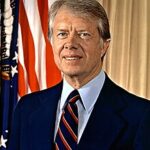President Jimmy Carter faced one of his greatest challenges during the 1979 oil crisis. The Carter energy crisis began when Iranian oil production dropped dramatically following the revolution. Carter’s response included conservation measures and gas rationing policies that many Americans found inadequate.
The Carter Energy Crisis Unfolds
Iranian oil exports fell by 4.8 million barrels daily in early 1979. This shortage triggered panic buying across American gas stations. Carter initially downplayed the severity of the situation. His administration hoped voluntary conservation would solve the problem quickly. ⚠️ However, gas lines grew longer as supplies dwindled nationwide.
Policy Response and Public Frustration
Carter implemented odd-even rationing based on license plate numbers. He also established a national 55 mph speed limit to conserve fuel. The president delivered his famous “malaise” speech in July 1979. 📊 Gas prices rose 60% between April and July that year. Americans waited hours in line for basic transportation needs.
Political Consequences Mount
The Carter energy crisis became a symbol of presidential weakness. Media coverage showed frustrated drivers and empty gas stations daily. Carter’s approval ratings dropped to 25% during the crisis peak. 💰 The economic impact included rising inflation and reduced consumer spending.
Impact:
The Carter energy crisis fundamentally altered American politics and energy policy. Carter lost significant public trust during the gas shortage crisis. His presidency never recovered from the perceived mismanagement of energy resources.
Economic Devastation Spreads
The energy crisis triggered a severe recession in 1980. 📉 Inflation reached 14.8% by March 1980, crushing middle-class families. Unemployment rose as businesses struggled with high energy costs. The automotive industry suffered massive losses as consumers avoided gas-guzzling vehicles. Small businesses dependent on transportation faced bankruptcy or closure.
Political Fallout Transforms Elections
🔥 Carter’s handling became central to the 1980 presidential campaign. Ronald Reagan successfully used the gas lines against Carter. Voters associated long gas lines with Democratic energy policies. The crisis contributed directly to Carter’s landslide defeat in November. Republican messaging about energy independence gained permanent political traction.
Long-term Policy Changes
The crisis accelerated development of alternative energy sources nationwide. Congress passed legislation promoting solar and wind power development. 🌍 America began strategic petroleum reserve stockpiling after 1979. Fuel efficiency standards became mandatory for automotive manufacturers. The crisis also strengthened arguments for domestic oil production expansion.
